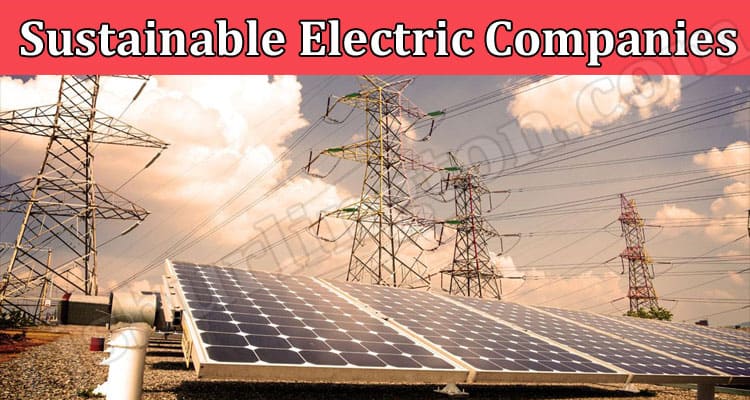With the global energy system poised for a significant transformation, companies focusing on sustainability are positioned for growth. They are reducing emissions, optimizing energy uses, and making clean, renewable energy accessible to the masses.
The world’s top sustainable electric companies are delivering on their promises. They build resilient clean energy systems and drive progress toward the 1.5-degree pathway.
What Are They?
Many energy companies embrace sustainable practices, recognizing the need to reduce greenhouse gas emissions for a climate-safe world. With the cost of renewable electricity dramatically falling, it’s becoming more affordable and viable for businesses to adopt clean energy sources.
Companies leading this transition include an electric company in Dallas, Texas. These companies offer a wide range of renewable energy services, from providing customers with a personalized experience to designing and installing power generation systems that meet their needs.
To reduce the world’s reliance on fossil fuels, these companies are focused on finding ways to generate and store renewable energy, including solar, wind, biomass, geothermal, hydroelectric, and nuclear power. This helps to provide a cleaner alternative for residential and commercial energy consumption and transportation needs.
These companies also focus on reducing carbon footprints across their operations, supply chains, and products. They invest in new technologies, implement policies and programs, and prioritize greener products. In addition to promoting sustainability initiatives, these companies also leverage their business platforms and resources to create greater awareness about the importance of going green. They also foster an inclusive environment for their employees and encourage them to participate in the movement toward a sustainable future.
What Are They Doing?
With demand for energy soaring and the world’s supply of fossil fuels depleting faster than they can be replaced, attention has returned to the vast sources of power surging around us in nature: solar, wind, and seas. It is only natural that more and more energy companies are focusing on these cleaner alternatives to cut carbon emissions, reduce costs and provide employment.
These companies are investing in new technologies to harness this renewable energy and help the global economy transition from dependence on carbon-based fossil fuels. The result is a cleaner and greener power source, delivering environmental, societal, and economic benefits.
Renewables also produce low-carbon transportation fuels such as sustainable biomass and high-percentage biofuel blends and electro-fuels for long-haul transport, aviation, and shipping. In addition, clean electricity can be stored in batteries to support EV charging stations and feed energy into the grid at peak load times.
Some of the best sustainable energy companies focus on clean, renewable, and zero-carbon energy sources such as onshore and offshore wind, pumped hydro, solar photovoltaic, battery storage, and hydrogen from renewable natural gas (RNG). This is driving down costs and emissions, helping to address climate change.
What Are They Making?
Many companies make products, services, and processes that reduce or eliminate environmental impacts. These green power companies are helping to fight climate change and provide a sustainable energy source for the world.
They are leveraging new technologies to harness the vast energy sources surging around us in nature: solar and wind, and ocean thermal and wave energy. But utilizing these sources as electricity for consumers is still challenging: their supply does not correspond to demand, and backup generating capacity is required to cover the intermittent nature of the renewables. And system costs escalate with increasing proportions of renewables in the mix.
These companies are addressing these challenges using technology to improve efficiency and reduce renewable energy costs. They are rethinking their business models and operating environments in light of the carbon-neutral emerging carbon-neutral eras signing up to a target of limiting global warming to two degrees Celsius.
Some companies pioneered a model that enables more households to access solar panels and batteries. It installs residential solar panels and offers a personalized experience for its customers. They are also committed to reducing the impact of its operations on wildlife and ecosystems, and it works to identify and prevent pollution from its production processes.
What Are They Saying?
With a global population exceeding 7 billion, the demand for reliable and affordable energy is skyrocketing. The good news is that vast energy sources are surging around us in nature, notably sunlight and wind, which can be harnessed to produce electricity without producing carbon dioxide emissions.
But renewables have yet to reach the point where they can be relied on to meet all of our energy needs, especially in baseload power, because their generating capacity is intermittent, and their availability depends on weather conditions. This can be overcome with battery storage and the emergence of hydrogen technology to provide backup for solar and wind, but these are expensive and time-consuming to develop.
Achieving the goal of 100 percent renewables will require all these options and more — from the widespread deployment of renewables to new ways to manage the grid, such as carbon capture, use, and storage (CCUS). And it’s not only governments and utilities that need to play a role; private consumers, businesses, and communities can make the most impact by choosing clean energy.
Many of the world’s leading companies are beginning to recognize this, with more committing to go 100% renewable in their offices and supply chains while demanding climate solutions from their suppliers and investing in new technologies to mitigate carbon footprints. This enables them to reap the benefits of the green economy and drive long-term competitiveness while protecting the environment for future generations.


